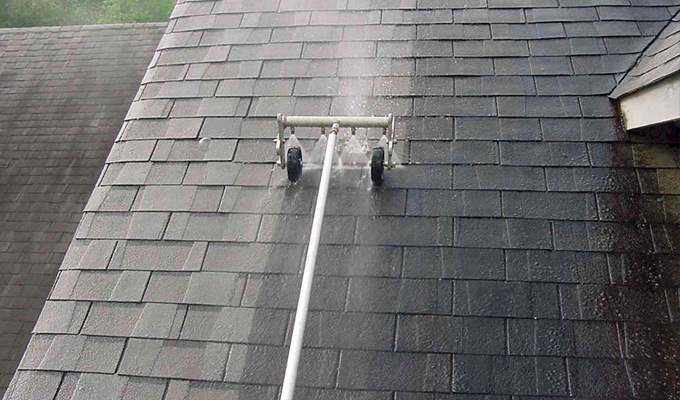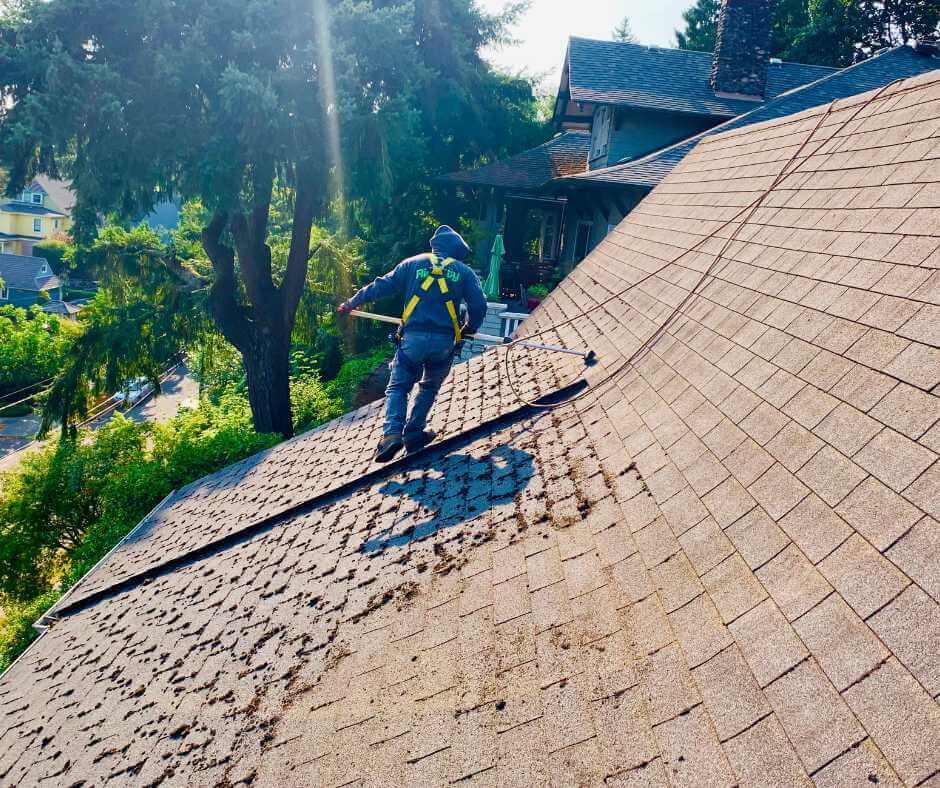Roof Moss Removal: How to Tackle This Typical House Owner Difficulty
Roof Moss Removal: How to Tackle This Typical House Owner Difficulty
Blog Article
Discover the most effective Practices for Roof Moss Elimination and Prevention
The relentless difficulty of roof moss can lead to substantial damages if not dealt with without delay and successfully. Identifying key locations susceptible to moss development is the first action in protecting your roof covering's stability. What are the most effective methods to ensure a moss-free roofing while maintaining ecological responsibility and cost-effectiveness?
Identifying Roof Covering Moss Issues
Determining roof moss problems is a vital action in maintaining the durability and honesty of your roof. Moss, an environment-friendly, spongy plant, tends to flourish in wet, shaded areas, making roofs with overhanging trees or in regions with constant rainfall specifically vulnerable. If left unattended, its visibility can lead to substantial damages. Moss retains wetness, which can bring about the deterioration of roof products, potentially causing leakages or architectural damages over time.
To effectively identify moss issues, perform normal examinations, specifically after extended periods of rainfall. Try to find patches of dark or environment-friendly staining on the roofing's surface, particularly along the shingles' sides where moss can conveniently secure. Furthermore, inspect the gutter systems and downspouts for any kind of particles that may show moss growth, as these locations can facilitate wetness accumulation.
Acknowledging very early indications of moss growth enables timely intervention, preventing more issues. In addition, it is essential to analyze the roof covering's direct exposure to sunlight and make certain ample drainage to minimize future incidents. By understanding the problems favorable to moss growth and consistently checking your roof, you can safeguard against potential damage, maintaining the roofing's performance and visual allure.
Do It Yourself Moss Elimination Methods
Once roofing system moss concerns are recognized, addressing them promptly can protect against additional damage. DIY moss elimination offers an economical technique for homeowners eager to invest time and initiative.
A typical do it yourself approach entails making use of a combination of equivalent components water and vinegar. Fill up a spray bottle with the remedy and use it directly to the moss-covered locations. Enable the remedy to sit for 20 to thirty minutes. This deteriorates the moss, promoting simpler elimination. As soon as the moss is loosened up, use a soft-bristle brush or mop to delicately scrub it away, taking care not to harm the roof shingles.
Rinse the roofing completely with water to make sure all remedy deposits are removed. Consistently evaluate your roof covering post-treatment to catch any kind of repeating moss early, keeping the roof covering's stability and long life.

Expert Moss Treatment Choices
When managing considerable roofing system moss problems, expert moss treatment options give a dependable and effective service. Engaging the expertise of experts ensures a comprehensive method, leveraging specialized devices and commercial-grade treatments that are usually more potent than those available to the typical home owner. These services normally begin with a thorough inspection to assess the extent and extent of moss growth, adhered to by sites the application of targeted therapies made to eradicate moss while preserving the stability of the roof covering materials.
Among the primary advantages of professional treatments is making use of top quality moss-killing agents that are both fast-acting and resilient. Specialists usually apply these agents making use of specialized devices, such as low-pressure sprayers, to make certain even coverage and avoid damage to the roofing system. Expert solutions regularly consist of follow-up inspections and maintenance plans to monitor roof problems and stop reoccurrence.
Furthermore, professional roofing system moss treatment providers are educated to identify underlying issues, such as inadequate drainage or insufficient sunshine, that may add to moss proliferation (roof moss removal). Addressing these origin triggers as part of a comprehensive treatment plan enhances the long-lasting effectiveness and sustainability of moss removal efforts, guaranteeing a clean and well-kept roof
Eco-Friendly Moss Prevention
Past the range of expert treatments, green moss prevention techniques supply sustainable choices for property owners aiming to preserve a moss-free roof. Baking soft drink raises the pH level, producing an unwelcoming environment for moss development.
Integrating copper or zinc strips along the roofing system ridge can serve as a preventative action - roof moss removal. When it rains, these steels release ions that prevent moss proliferation. This technique is not only eco-friendly however also offers a long-lasting solution without the demand for chemical treatments
An additional eco-conscious technique includes enhancing roof ventilation and sunlight exposure. Trimming overhanging tree branches permits more sunshine onto the roofing system, normally hindering moss by lowering dampness levels. Additionally, ensuring proper roof drainage can aid protect against water accumulation, a main catalyst web link for moss growth.
Routine Roof Covering Upkeep Tips
How typically should house owners take part in roof upkeep to guarantee longevity and performance? Ideally, house owners ought to perform a thorough roofing assessment bi-annually, ideally in springtime and autumn. These inspections enable for the early discovery of possible problems like harmed roof shingles, obstructed seamless gutters, or arising moss growth, which can compromise the roof covering's honesty if left unattended.
Regular cleansing is another vital facet of roofing system upkeep. Debris such as leaves, twigs, and dust should be removed to prevent water retention, which can cause moss and algae expansion. Cleansing rain gutters is just as important, as blocked rain gutters can trigger water overflow, damaging the roof covering and outside walls.
Along with cleaning, house owners must likewise be cautious about trimming looming branches. Trees that are as well near to the roofing system give shade and dampness, producing a suitable atmosphere for moss to thrive. Furthermore, branches can damage shingles throughout tornados, causing leaks.

Final Thought
Addressing roofing moss efficiently needs a thorough technique that integrates prevention, recognition, and elimination approaches. Normal maintenance and timely repair services significantly add to sustaining a moss-free roof, eventually lengthening the roof covering's life-span and boosting general architectural stability.
By recognizing the problems helpful to moss growth and regularly checking your roofing system, you can safeguard versus potential damages, maintaining the roofing system's performance and aesthetic allure.
Consistently examine your roof post-treatment to catch any type of recurring anchor moss early, preserving the roofing's integrity and longevity.
When dealing with comprehensive roofing moss problems, professional moss treatment choices provide a reliable and trusted option. These services normally begin with a detailed assessment to analyze the intensity and level of moss development, complied with by the application of targeted therapies designed to eliminate moss while preserving the stability of the roofing materials.
In addition, making sure proper roof drainage can assist stop water buildup, a main catalyst for moss growth.
Report this page